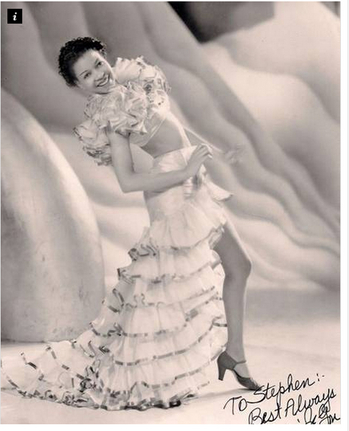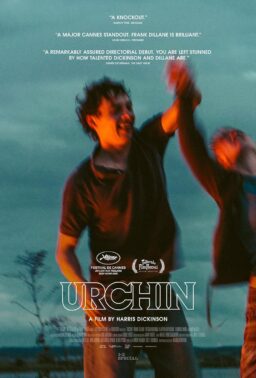My good Sun-Times pal from the 1970s at the Chicago Sun-Times, Cynthia Dagnal, wrote me today:
“A friend in London sent me this, obituary from the London indpendent and I was stunned to see that Jeni Le Gon attended the same Southside dancing school in Chicago that I did. It was probably the most reputable one on that side of the “color line,” and not very far from my house. So I studied with the younger “protégés” of Mary Bruce, and all those cute pics of me in little but EXPENSIVE tutus and whatnot that I sometimes use on my blogs are reminders of those days! I took tap, jazz and ballet as a wee one, and loved to walk around en pointe all day long in those danged–and also expensive–toe shoes!”
Le Gon (born in Georgia Aug. 24,1916; died December 7, 2012) was the first African-American women to sign with a major studio, but there was more to it that that. From the loving obit by Stephen Bourne in the Independent:
“Following her screen debut, the vivacious Le Gon was signed by MGM and paid the huge sum of $1,250 a week. They gave her a role in Broadway Melody of 1936 but, she said, “MGM hosted a party for the mayors of various cities and the cast of Broadway Melody of 1936 entertained them. Eleanor Powell, the famous tap dancer from Broadway, had also been signed for the movie and after I stopped the show on performance night at the mayors’ party, MGM decided they couldn’t have two tap dancers in the picture and I was dropped from the studio. If I had been white, they would have kept me because I could have developed into something, but they let me go. While I was at MGM I was told I wasn’t allowed to eat in the main dining room. Here, they were paying me $1,250 a week and telling me I wasn’t good enough to eat in their dining room. But Hollywood was no different to the rest of the country in that respect.”
Also from the obit:
” She played maids to Maria Montez in Arabian Nights (1942), Ann Miller in Easter Parade (1948) and Betty Hutton in Somebody Loves Me (1952). Tiring of maid roles, Le Gon faced humiliation in 1950 when she joined a group of black actors to call on Ronald Reagan, then president of the Screen Actors Guild. They raised their concerns about the stereotyping of black actors, but Reagan showed no interest: “We tried to get him to intervene for us, but he wasn’t the least bit sympathetic. He didn’t even lie about it.”
After moving with her family to Chicago, Le Gon attended Mary Bruce’s School of Dancing. At the age of 16, she embarked on a professional career after successfully auditioning for the chorus of the Count Basie Orchestra. After arriving in California in the mid-1930s, Le Gon’s energetic and expert dancing skills were noticed by Earl Dancer, a black producer and talent scout. Dancer took Le Gon under his wing and he was instrumental in bringing her to the attention of various Hollywood studios.
She made her film debut in RKO Radio’s Hooray for Love (1935), in a lively musical sequence in which she was teamed with Bill “Bojangles” Robinson and Fats Waller. The trio’s rendition of “I’m Livin’ in a Great Big Way” was sensational and, after Hooray for Love, Fats Waller employed Le Gon as a vocalist and dancer with his band. Le Gon explained to his biographer, Alyn Shipton, how Waller helped to shape her stage act: “I danced like a boy – I did flips and knee drops and toe stands and all that sort of business so, when I had to sing after I’d danced, he gave me these cute little numbers so that I could talk-sing.” In 1984, referring to her toe stands, and to Michael Jackson, Le Gon commented: “That Michael fella, they say he invented it. All the girls from my era did that.”
Le Gon was warmly received in Britain when she opened at London’s Adelphi Theatre on 4 February 1936 in CB Cochran’s revue Follow the Sun. Later that year, she was featured as a cabaret dancer in the British film Dishonour Bright. She said: “I experienced being a real person for the first time. On board the ship and in Europe I was referred to as Miss Le Gon and that had never happened to me before.”
“On a tour of Canada in 1969 she found herself in Vancouver and agreed to hold a few workshops during the two days she was there, “but the students began lining up before we had even rented space. In Vancouver, I found out I was a person. Period. I didn’t have to worry about going somewhere and hearing somebody say, ‘No, you can’t come in.’ That’s one of the reasons I stayed in Canada.”
¶
Jeni Le Gon with Biill (Bojangles) Robinson and Fats Waller in “I’m Living in a Great Big Way” (1935).
“Swing is Here to Stay” (1937), co starring the zoftig Dixon Sisters. When she leans at the end, they nailed her shoes to the floor.
Full-length film: “Double Deal” (1939), with Monte Hawley and Edward Thompson
With Cab Calloway in “HI De Ho” (1947)
Jeni performs in “I’m Living in a Great Big Way” in 2007 in the Century Ball Room in Seattle.
Jeni performs her last dance, it says, at the 2008 Masters of Lindy and Tap. Somehow I don’t believe this was her last dance.
Jeni at 90
A December 2012 tribute to Dr. Jeni Legon
Photo at top from the London Independent, autographed to Stephen Bourne, the author of the obituary.



…and above is my friend Cynthia Dagnal herself, when she was attending the same dance studio, about 10 and dolled up to look 30.
She writes: “Distinctive “Chicago style” just makes my eyes tear up. Whenever I hear Gene Kelly say, “Le time step,” in An American in Paris, I think of that step–everyone does it, but we did it with Chicago swag. Here’s a shot of me all dolled up and looking about 30-years-old.
“Here’s a little blurb piece on both Sadie and Mary Bruce’s dance schools from the Chicago Public Library. Both schools were amazing–in fact, when I read this, I thought, “Okay…which one WAS it?” I think I had to go to Sadie’s for a while because there wasn’t room at Mary’s for a wee one, but it was sooooooo long ago, I don’t even remember all that very well.
http://bit.ly/WUiaOJ
“Doesn’t matter, they were both amazing women and both schools were a VERY big deal on the Southside. Every parent wanted to get their kids into a class at either one, and I felt so lucky to be able to dance there. We had huge recitals all the time, and I loved every minute of those very serious shows.












